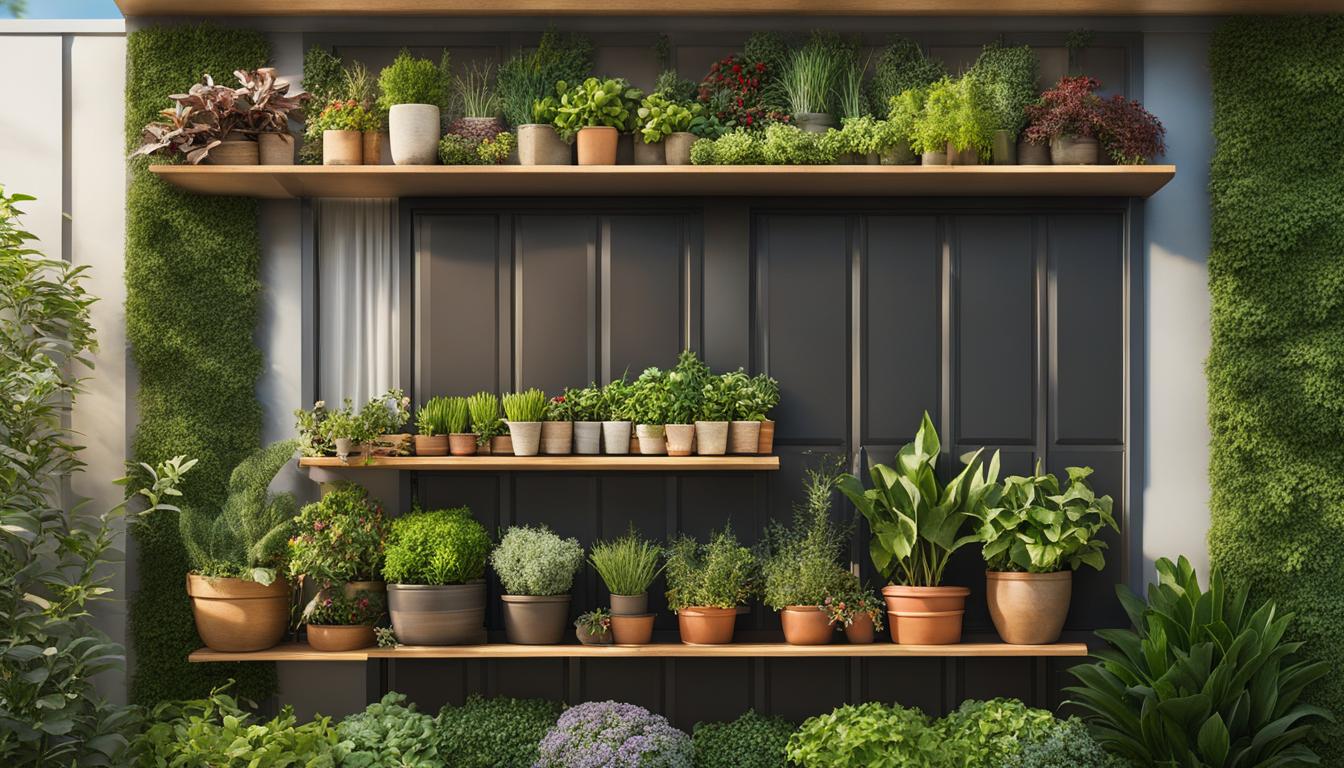Are you interested in growing your own food but live in a small space? Don’t worry, urban gardening has got you covered! With a focus on planting in small areas, urban gardeners can transform their front yards, balconies, or even indoor spaces into productive vegetable gardens. So, let’s dive into the world of urban gardening and discover how you can cultivate your very own green oasis, no matter how limited your space may be.
Key Takeaways:
- Urban gardening allows individuals to grow their own food in small spaces.
- Planting in small areas such as front yards, balconies, or indoor spaces can turn them into productive vegetable gardens.
- Benefits of urban gardens include reduced water consumption, lower carbon footprint, improved air quality, and natural pest control.
- Choosing the right space and utilizing techniques like container gardening and vertical gardening are essential for successful urban gardening.
- Selecting suitable plants, ensuring proper maintenance, and overcoming challenges are crucial for a thriving urban garden.
Benefits of Urban Gardens
Urban gardens offer a multitude of benefits, making them an increasingly popular choice for sustainable urban gardening. One of the key advantages is their ability to significantly reduce water consumption compared to traditional lawns. Studies estimate that urban gardens can consume up to 66% less water, helping conserve this valuable resource in water-scarce areas.
Another notable benefit of urban gardens is their positive impact on the environment. By growing their own food, urban gardeners reduce their carbon footprint by eliminating the need for long-distance transportation of produce. This not only reduces greenhouse gas emissions but also supports local food systems. Additionally, the plants in urban gardens act as natural air purifiers, converting carbon dioxide into oxygen and improving air quality.
Urban gardens also provide a natural solution for pest control. Through strategic planting and companion planting techniques, gardeners can create a balance in their garden ecosystem, attracting beneficial insects that prey on pests. This reduces the need for harmful chemical pesticides, promoting a healthier environment for both humans and wildlife.
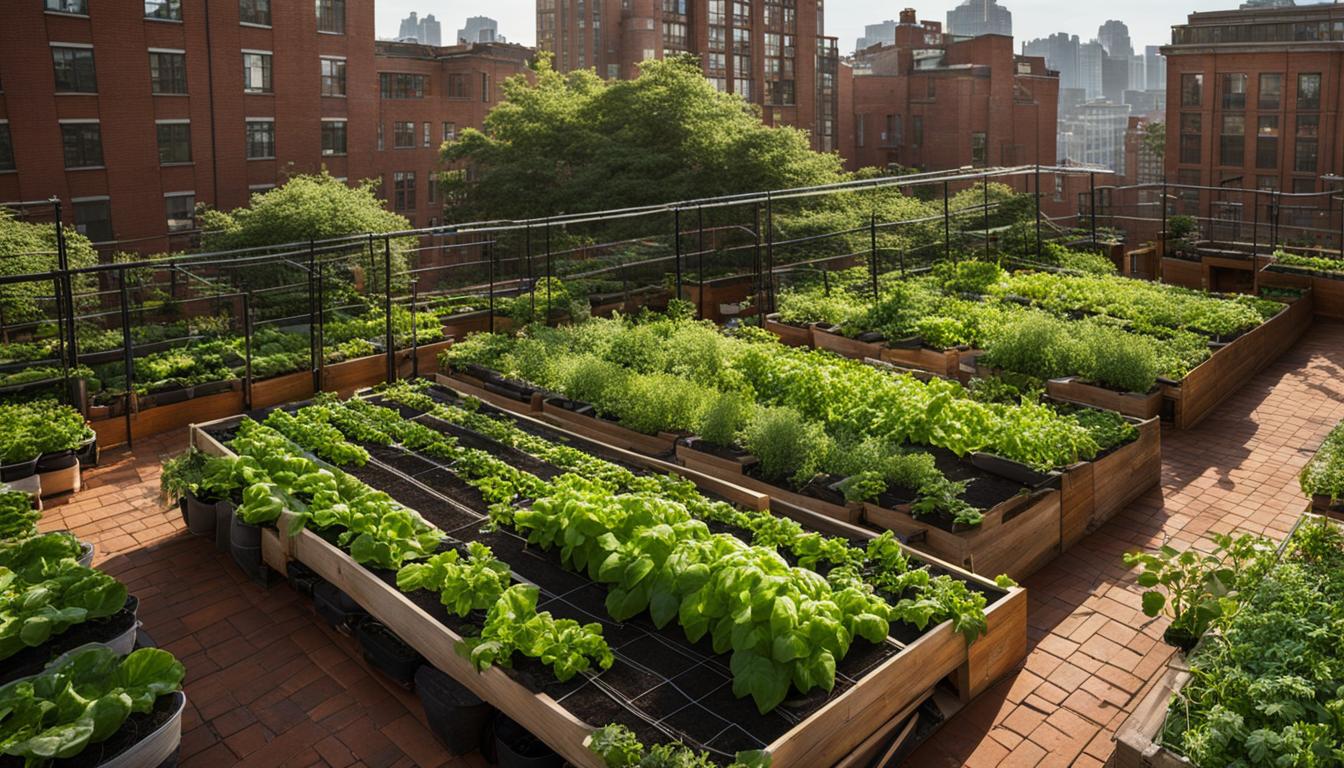
Key Benefits of Urban Gardens:
- Significant reduction in water consumption
- Lower carbon footprint and support for local food systems
- Natural air purification and improved air quality
- Natural pest control through strategic planting and companion planting
“Urban gardens offer a sustainable alternative for growing food, conserving water, reducing carbon emissions, improving air quality, and promoting natural pest control.”
Choosing the Right Space for Urban Gardening
Urban gardening offers a wonderful opportunity to grow your own food and connect with nature, even in small spaces. The key to successful urban gardening is choosing the right space that suits your needs and the plants you want to grow. Here are some tips for finding the perfect spot:
Assess Available Sunlight
Before deciding on a space for your urban garden, it’s essential to assess the amount of sunlight the area receives. Most vegetables and herbs require at least 6 hours of direct sunlight per day to thrive. Observe the space at different times of the day to determine if it gets enough sun. If your available space has limited exposure to sunlight, consider growing shade-tolerant plants like lettuce, spinach, or herbs that can tolerate partial shade.
Consider the Size of Your Space
When choosing a space for urban gardening, consider the available area you have to work with. If you have a small yard or front space, you can transform it into a productive vegetable garden. Balconies can also be utilized by using vertical gardening techniques or window boxes. Even indoor spaces with sufficient lighting can be turned into thriving urban gardens. Think about how much space you have and how many plants you want to grow to ensure you can accommodate your garden comfortably.
Ensure Proper Drainage
It’s important to consider the drainage capabilities of your chosen space. Urban gardens often rely on containers or raised beds, and these require proper drainage to prevent waterlogging and root rot. If your space doesn’t naturally drain well, you can improve it by using raised beds filled with well-draining soil. Additionally, ensure that any container you use has sufficient drainage holes at the bottom.
By carefully selecting the right space for your urban garden, you can create a thriving oasis even in the most limited surroundings. Whether it’s a sunny balcony or a small backyard, with a little planning and creativity, you can grow your own fresh produce and enjoy the benefits of urban gardening.
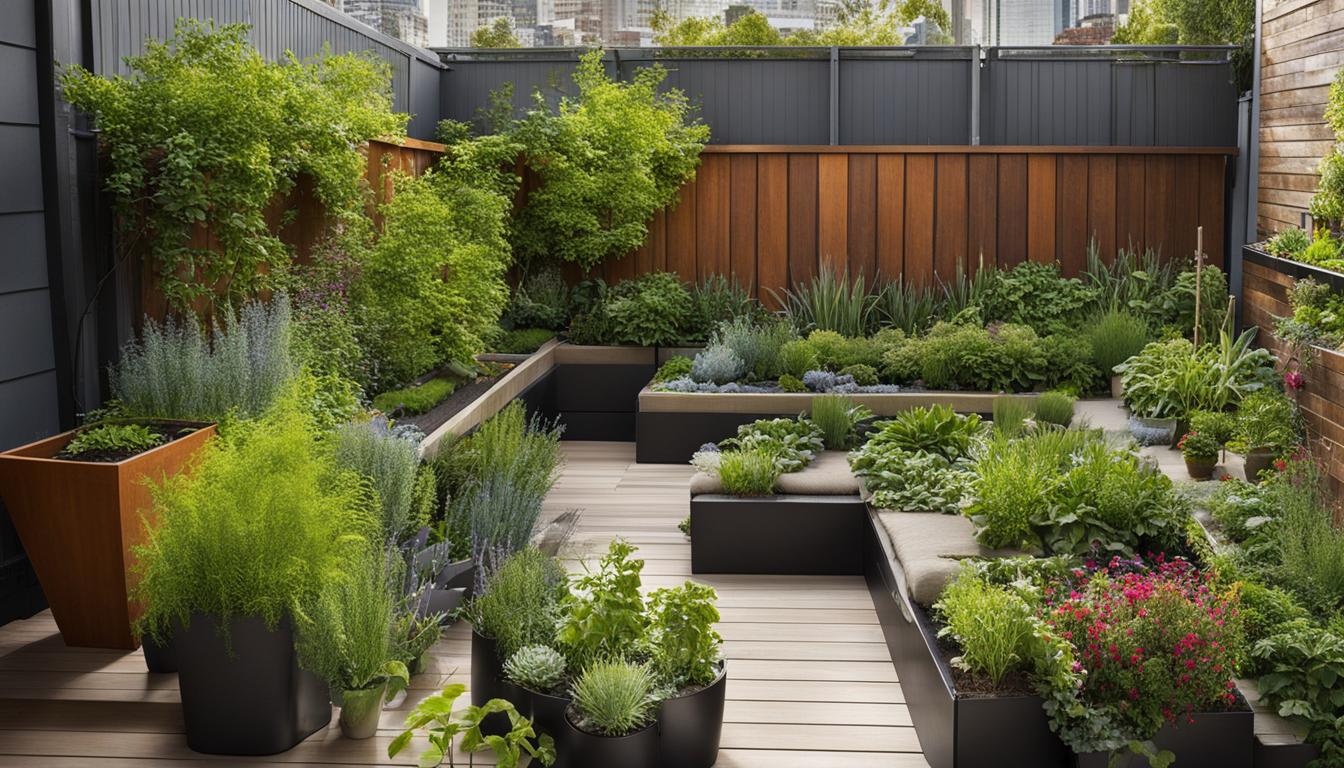
Container Gardening for Small Spaces
Container gardening is a popular and effective technique for urban gardeners with limited outdoor space. It allows individuals to grow a wide range of vegetables and fruits in containers of various sizes, maximizing the use of small areas. The benefits of container gardening are numerous. Not only does it provide a space-efficient solution for urban gardeners, but it also offers easy maintenance and the ability to move the containers for optimal sunlight exposure.
When practicing container gardening, it’s essential to provide the plants with adequate care. Regular watering is crucial, ensuring the soil remains moist but not waterlogged. Choosing the right soil mix for containers and adding appropriate nutrients will help plants thrive in these confined spaces. Additionally, container gardening offers the flexibility to experiment with different plant varieties, creating a diverse and visually appealing urban garden.
Benefits of Container Gardening:
- Space efficiency
- Easy maintenance
- Optimal sunlight exposure
- Diverse plant varieties
Container gardening allows urban gardeners to maximize their small spaces and turn them into productive gardens.
Whether you have a balcony, rooftop, or small patio, container gardening can transform these areas into flourishing green spaces. It’s important to choose the appropriate containers based on the plant’s size and root system. Vegetables like tomatoes, peppers, and herbs do well in medium-sized containers, while smaller plants like lettuce and radishes can thrive in smaller pots.
With container gardening, urban gardeners can enjoy the satisfaction of growing their own food while beautifying their surroundings. It’s a technique that offers versatility, creativity, and the opportunity to experience the joys of gardening in even the smallest of spaces. Start your container garden today and discover the wonders of urban gardening in a whole new way!

Vertical Gardening for Maximizing Space
Vertical gardening is gaining popularity as a trendy technique in the world of urban gardening. With limited space, urban gardeners are finding innovative ways to maximize their growing area by utilizing vertical structures. Whether you have a small balcony or a tiny backyard, vertical gardening offers a solution to make the most of your available space. By growing plants upwards instead of outwards, you can create a lush and productive garden in even the smallest urban settings.
One of the advantages of vertical gardening is its space-saving nature. By utilizing trellises, pallet planters, or hanging systems, you can grow a variety of vegetables, fruits, and herbs without taking up valuable ground space. Imagine a wall of vibrant green foliage, with tomatoes, peas, pole beans, cucumbers, and herbs gracefully climbing upwards. Not only will this make your garden visually appealing, but it will also provide a bountiful harvest.
Vertical gardening also offers an aesthetic element to urban gardens. The combination of different plants growing vertically creates a stunning visual display that can transform any small space into a beautiful oasis. In addition, vertical gardening allows for easy access to your plants for watering, pruning, and harvesting. It simplifies maintenance and makes gardening more enjoyable, even for those with limited mobility.
Benefits of Vertical Gardening:
- Maximizes limited space
- Creates a visually appealing garden
- Provides easy access for maintenance
- Allows for a diverse range of plants
- Increases harvest yield
So, if you’re looking to make the most of your small space, why not try vertical gardening? It’s a trendy and practical technique that will not only provide you with a lush and productive garden but also add beauty and charm to your urban environment.

Raised Beds and Square Foot Gardening
Raised beds and square foot gardening are popular techniques for urban gardeners with limited space. These methods offer several advantages that make them ideal for small urban gardens.
- Raised beds provide an extended growing season by allowing the soil to warm up faster in the spring and retain heat in the fall, enabling urban gardeners to cultivate a wider variety of plants.
- With raised beds, excellent drainage is ensured, preventing waterlogged soil and the risk of root rot. This is especially beneficial in urban areas where poorly drained soil is common.
- The controlled environment of raised beds helps reduce weed growth, making maintenance much easier for urban gardeners.
- Furthermore, raised beds allow for more plants to be grown in a smaller space. The soil can be customized with essential nutrients, creating optimal conditions for plant growth and productivity.
Square foot gardening is another efficient technique for small space urban gardening. This method involves dividing the growing space into small sections, typically 1 square foot each, maximizing the use of space and resources. By carefully planning and arranging plants in a grid pattern, urban gardeners can optimize yields and minimize wasted space.
“Raised beds and square foot gardening are excellent techniques for urban gardeners who want to make the most of their limited space. With these methods, you can enjoy an extended growing season, reduce weed growth, and achieve higher yields. Whether you choose raised beds or square foot gardening, these techniques are perfect for small urban gardens.”
Both raised beds and square foot gardening offer urban gardeners the opportunity to create highly productive and organized gardens in small spaces. These techniques are highly adaptable and can be customized to suit individual preferences and gardening goals.
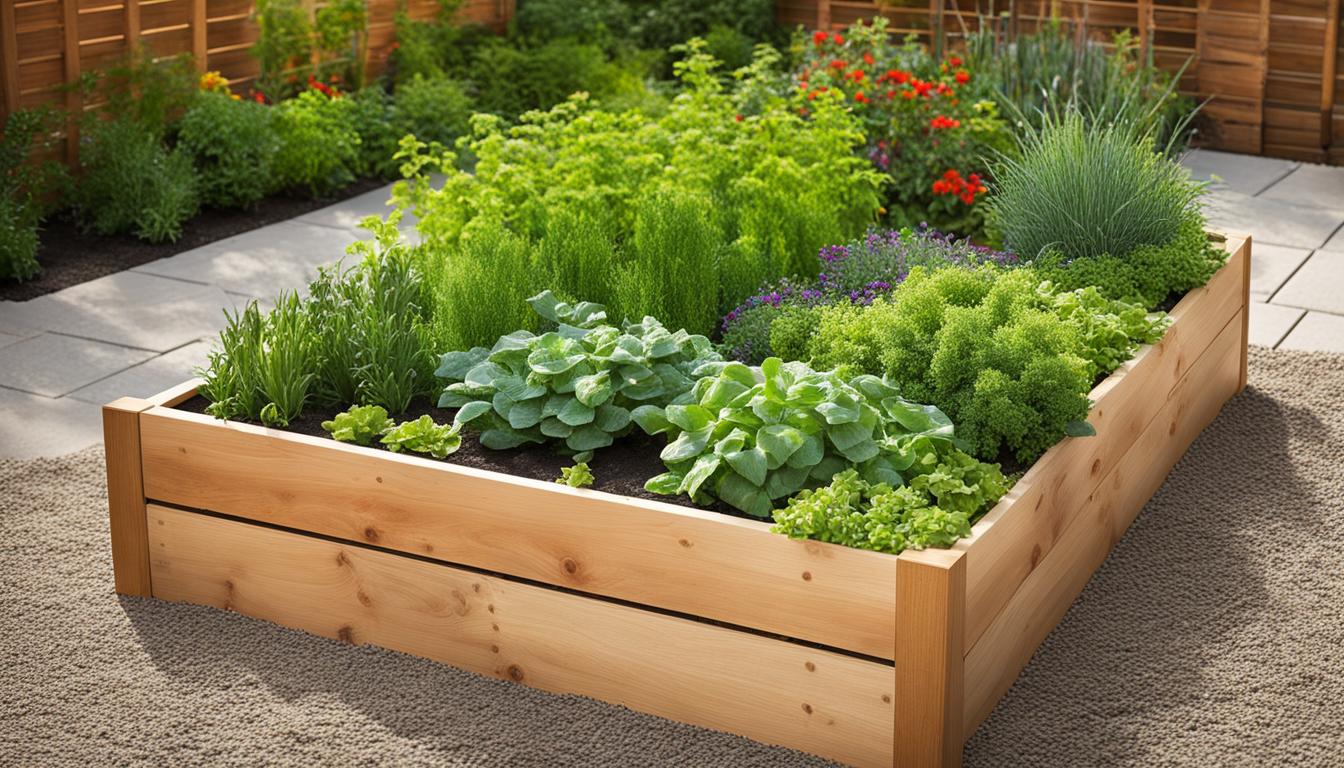
Choosing the Right Plants for Your Urban Garden
When it comes to urban gardening, selecting the right plants is essential for success. With limited space and specific growing conditions, it’s important to choose plants that are well-suited for small spaces and are adaptable to partial shade. Here are some urban gardening ideas for choosing the right plants:
1. Vertical and Climbing Plants
Vertical gardening is a fantastic way to maximize space in small urban gardens. Plants such as tomatoes, cucumbers, and pole beans thrive when grown vertically. These plants can be trained to climb trellises, walls, or fences, allowing you to grow more in limited space. Consider incorporating beautiful flowering vines like morning glories or nasturtiums for added visual appeal.
2. Compact and Dwarf Varieties
Opting for compact or dwarf varieties of vegetables and herbs is another great strategy for small space urban gardening. These varieties are specifically bred to grow well in containers or small garden beds. Look for compact tomatoes, bush beans, or miniature herbs like basil or thyme. Compact plants not only fit well in limited spaces but also require less maintenance and are easier to manage.
3. Container-Friendly Plants
Container gardening is a popular choice for urban gardeners, and selecting plants that thrive in containers is crucial. Herbs like parsley, mint, and chives are excellent choices for containers as they are compact and can be harvested frequently. Leafy greens like lettuce or spinach also do well in containers and can be grown in small pockets of soil or even hydroponically. Additionally, consider edible flowers like marigolds or pansies to add a pop of color to your urban garden.
Remember, it’s important to consider the amount of sunlight your garden receives and select plants accordingly. Some plants thrive in full sun, while others can tolerate partial shade. Local nurseries or online gardening resources can provide valuable guidance on suitable plant varieties for your specific urban garden.
Tips for Successful Urban Gardening
Urban gardening can be a rewarding and fulfilling experience, allowing you to grow your own fresh produce even in small spaces. To ensure a successful urban gardening journey, here are some essential tips to keep in mind:
Adequate watering and soil quality:
Water is crucial for the health and growth of your plants. Make sure to water them regularly, especially during hot and dry periods. Ensure that your soil has good drainage to prevent waterlogging, which can lead to root rot. Additionally, use high-quality soil or amend your existing soil with organic matter to provide essential nutrients for your plants.
Regular fertilization:
Just like any other garden, urban gardens benefit from regular fertilization. Use organic fertilizers or compost to provide your plants with the necessary nutrients for healthy growth. Follow the recommended application rates and schedule to avoid overfertilization, which can damage your plants.
Pest and disease control:
Monitor your plants regularly for pests and diseases and take prompt action if any issues arise. Remove weeds regularly, as they can harbor pests and compete with your plants for nutrients. Consider using natural pest control methods such as companion planting or introducing beneficial insects to your garden.
Engaging with the gardening community:
Joining local gardening communities or online forums can provide valuable tips, advice, and support from experienced urban gardeners. You can learn from their experiences, get answers to your questions, and stay updated on the latest urban gardening trends and techniques.
By following these tips, you can create a thriving urban garden, regardless of the size of your space. Remember to be patient and enjoy the journey. Happy gardening!
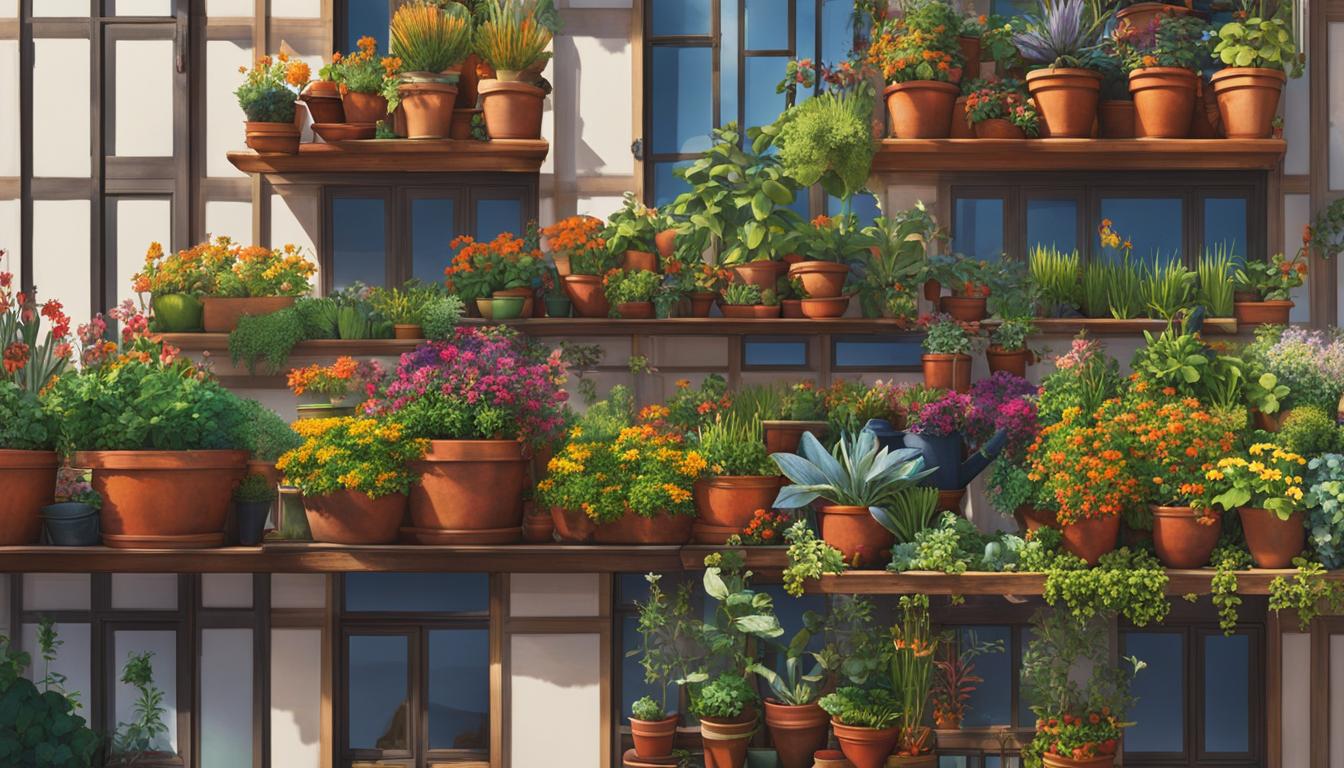
Overcoming Challenges in Urban Gardening
Urban gardening may present some challenges, but with the right techniques and strategies, these obstacles can be overcome. One common hurdle in urban gardening is limited space. However, by utilizing vertical gardening techniques, such as trellises and hanging systems, gardeners can maximize their available space and grow a variety of crops. Container gardening is another effective solution, allowing plants to thrive in small areas such as balconies or window boxes. Additionally, raised beds and square foot gardening techniques offer increased productivity and optimal use of space.
Another challenge in urban gardening is the lack of direct sunlight, especially for those with shaded balconies or indoor gardens. In such cases, it is important to select plants that are suitable for partial shade and to strategically place them in areas where they can receive the most sunlight. Choosing shade-tolerant plant varieties will ensure successful growth and yield.
Pest control is another aspect to consider in urban gardening. Limited space and proximity to other gardens or green areas can make urban gardens more susceptible to pests. However, implementing strategic planting techniques, such as companion planting, can naturally deter pests and maintain a healthy, pest-resistant garden. Regular monitoring and prompt action at the first sign of pests or diseases is essential in preventing outbreaks and preserving plant health.
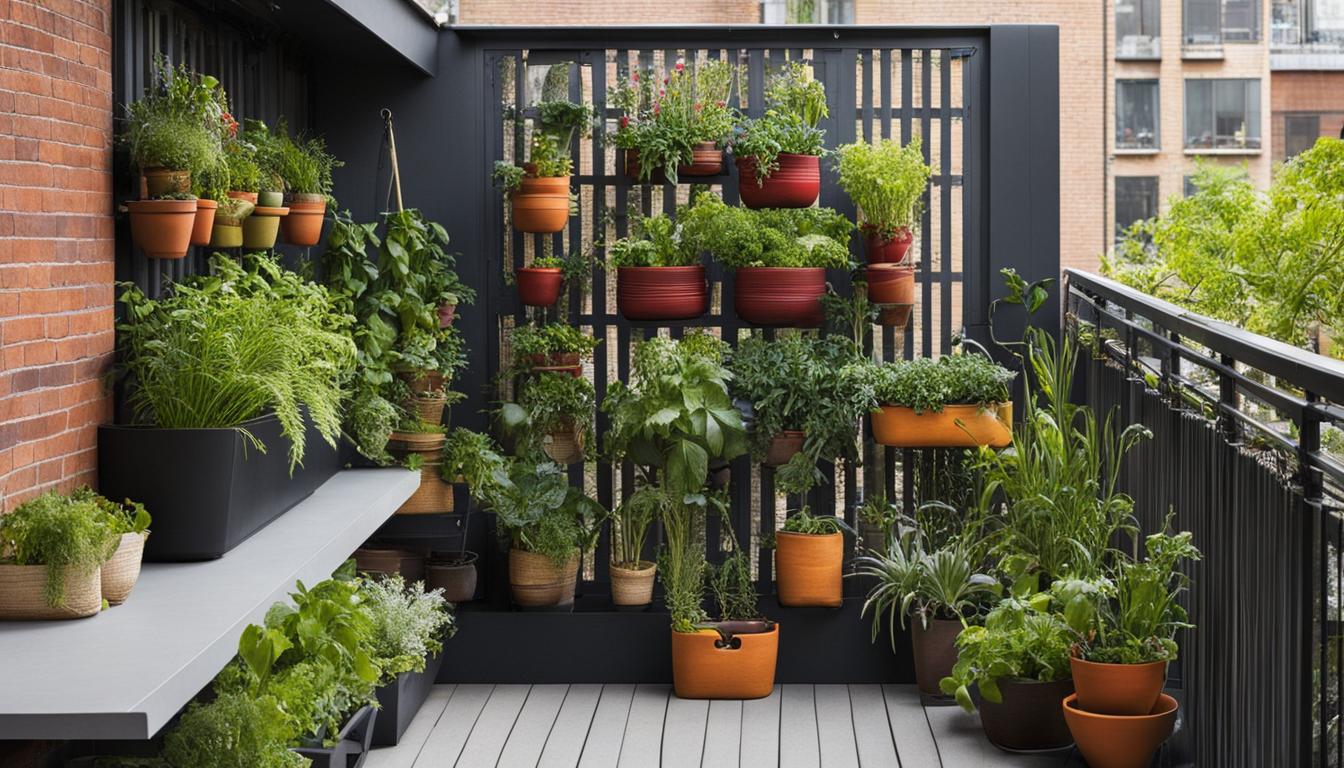
Key Takeaways:
- Maximize limited space in urban gardens through vertical gardening techniques and container gardening.
- Select plants suitable for partial shade and strategically position them to optimize sunlight exposure.
- Implement natural pest control methods, such as companion planting, to deter pests and maintain a healthy garden.
Enhancing the Urban Garden Experience
Creating an urban garden is not just about growing food; it’s also an opportunity to express your creativity and make a beautiful space. Here are some ideas to enhance your urban garden:
1. Add decorative planters: Choose unique and colorful planters to add visual interest to your garden. Mix and match different sizes and shapes to create a vibrant and eclectic look.
2. Incorporate trellises and vertical structures: Use trellises or vertical structures to create visual height and maximize your space. Train climbing plants such as vines or flowers to grow upwards, adding a sense of drama and beauty to your garden.
3. Create seating areas: Designate a cozy corner or seating area where you can relax and enjoy your urban oasis. Add comfortable chairs or benches, and surround yourself with lush greenery for a peaceful and tranquil atmosphere.
4. Experiment with unique plant varieties: Explore different types of plants, such as heirloom vegetables, rare flowers, or exotic herbs. This allows you to discover new flavors and textures while adding intrigue to your garden.
5. Embrace urban gardening trends: Stay up-to-date with the latest urban gardening trends. For example, you could try vertical herb gardens or create a pollinator-friendly garden to attract bees and butterflies.
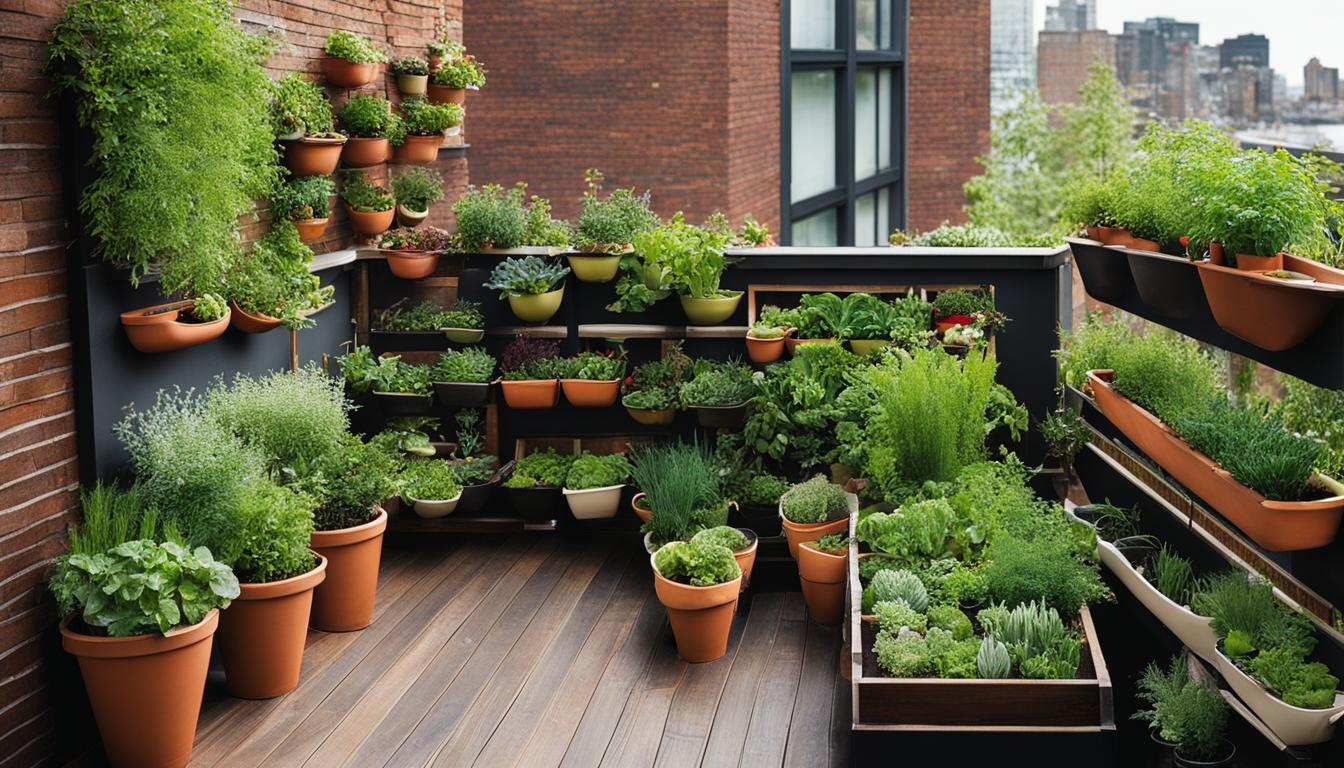
By incorporating these ideas into your urban garden, you can transform it into a unique and inviting space. Remember to personalize your garden based on your preferences and desired aesthetic. Experiment, have fun, and let your urban garden become a reflection of your creativity and love for nature.
Conclusion
Urban gardening is a fantastic way for beginners to connect with nature and grow their own food, even in small spaces. With techniques like container gardening, vertical gardening, and raised beds, urban gardeners can make the most of their available space and enjoy the benefits of fresh, homegrown produce.
By carefully planning their urban gardens and selecting suitable plants, beginners can embark on a successful urban gardening journey. It’s important to pay attention to factors like watering, soil quality, and regular maintenance to ensure healthy and productive plants. Engaging with local gardening communities or online forums can also provide valuable tips and advice from experienced urban gardeners.
So, whether you have a tiny balcony, a small front yard, or even just indoor space with sufficient lighting, urban gardening is a rewarding adventure waiting to happen. Start your own urban garden today and experience the joy of growing your own food in the comfort of your own home!
FAQ
What is urban gardening?
Urban gardening is the practice of growing plants, particularly fruits and vegetables, in small spaces such as front yards, balconies, or even indoor areas.
What are the benefits of urban gardening?
Urban gardening offers several benefits, including reduced water consumption, decreased carbon footprint, improved air quality, and natural pest control.
Can urban gardening be done in limited spaces?
Yes, urban gardening can be done in various spaces, depending on availability. Small yards, balconies, and even indoor areas with sufficient lighting can be utilized for urban gardening.
What is container gardening?
Container gardening involves growing plants in containers of various sizes. It is an excellent option for urban gardeners with limited outdoor space and offers benefits such as space efficiency and easy maintenance.
What is vertical gardening?
Vertical gardening is a technique that utilizes vertical structures such as trellises, pallet planters, or hanging systems to maximize space in urban gardens. It is ideal for growing vining vegetables and adds an aesthetic element to the garden.
What is raised bed gardening?
Raised bed gardening involves creating elevated planting areas that provide advantages such as extended growing seasons, excellent drainage, reduced weed growth, and easier maintenance.
How do I choose the right plants for my urban garden?
When choosing plants for your urban garden, consider the available space, sunlight exposure, and growing conditions. Focus on plants that can be grown vertically or in containers, and local nurseries or online sources can provide guidance on suitable plant varieties.
What are some tips for successful urban gardening?
Successful urban gardening requires attention to watering, soil quality, fertilization, pest control, pruning, and harvesting. Engaging with gardening communities and seeking advice from experienced gardeners can also be helpful.
What are some common challenges in urban gardening?
Limited space, lack of direct sunlight, and potential pest issues are common challenges in urban gardening. However, techniques such as vertical gardening, container gardening, and strategic plant placement can help overcome these obstacles.
How can I enhance my urban garden experience?
You can enhance your urban garden by adding aesthetic elements such as decorative planters, trellises, or landscaping features. Creating seating areas or a relaxing atmosphere can also make the space more inviting. Additionally, experimenting with unique plant varieties or exploring organic gardening practices can add to the experience.
How can I get started with urban gardening?
To get started with urban gardening, choose the right space, determine suitable plants, and ensure proper care and maintenance. By using techniques like container gardening or vertical gardening, even beginners can embark on a successful urban gardening journey.

